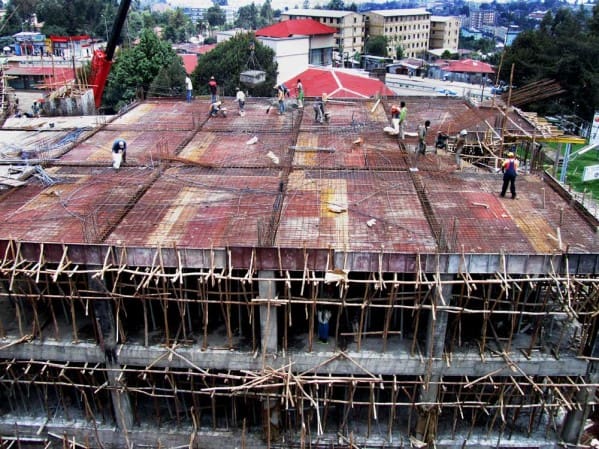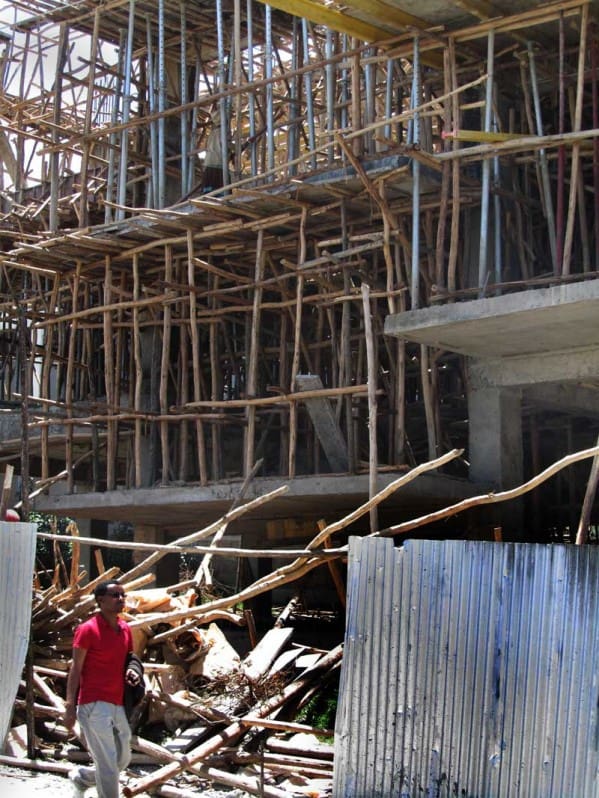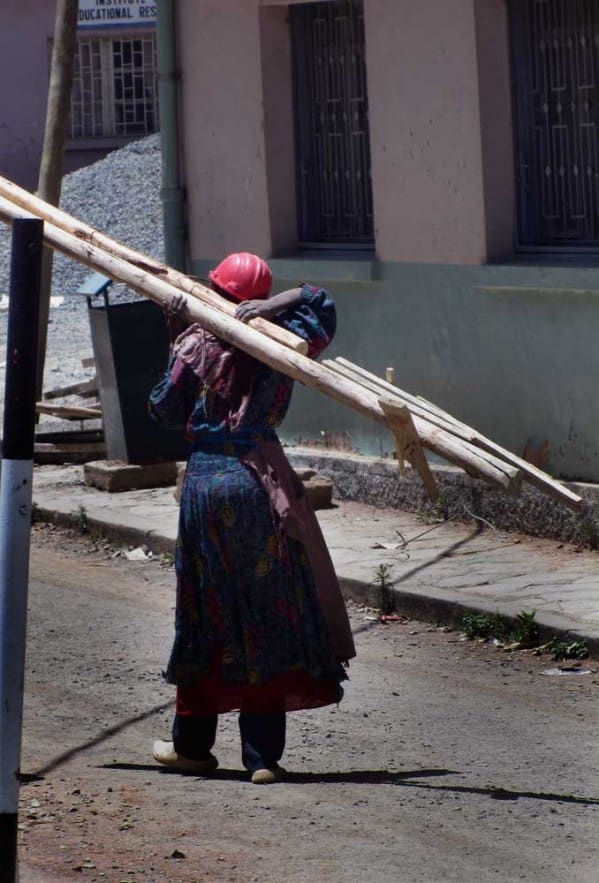Africa’s fastest-growing economy balances between dreams of the future and the shackles of the past
For those libertarians who feel that OSHA and any and all regulations on workplace safety are the very essence of neo-Stalinism, I submit the construction industry in modern Ethiopia. Please note that the scaffolding supporting this multi-story concrete building is basically lashed-together sapling trunks, and that while the workers are all wearing hardhats, the basic safety equipment you routinely see on construction sites in the West is pretty much lacking – no safety lines, no walkie-talkies to communicate with the crane operator, no nets or wind barriers at the periphery. Feel free to apply for a gig here, fellas.

This picture was taken under the baking-hot noonday African sun. The bucketful of cement on the way up seems to arrive at irregular intervals, and sometimes much to the surprise of the workers on the roof. I saw one bucket swing a little wildly and clip a guy off his feet. A little lower and to the side, and he would have been spread across the roof like grisly human jam on unyielding toast. (Click to enlarge)
Everywhere you look in Ethiopia, you can see massive infrastructure projects underway. High-rise apartments/office complexes, new highways, bridges, underpasses — the skyline of Addis Ababa is littered with cranes, and even the relatively sleepy resort town of Bahir Dar has big projects every few blocks. But the downside of such a mad scramble to develop is that growth at this scale does not happen without cutting a few corners.

It looks like a giant game of pick-up-sticks, but these crude, crooked, stripped saplings are the foundation of just about every large-scale construction project I've seen here. It's truly breathtaking when you see people scrambling up these rickety structures that are 10 or more stories above ground, and that you visibly flex and sway with the weight and the wind. Repeat: no safety lines or harnesses. (Click to enlarge)
The government here is in a race to get First World-style development projects done either before the international investment funds dry up, or the population growth exceeds the current carrying capacity of both the land and the cities, resulting in a systemic collapse and yet another cycle of war/famine/massive mortality.
All the countries on the African continent are walking this same razor’s edge; well, those that are not mired in civil war, ruled by evil kleptocracies, or that are content with resource-extraction economies that will last only as long as the mines or oil wells hold out.
I told the former Information Minister Bereket Simon that I thought that Ethiopia’s greatest resource is its people; that unlike some of the other countries facing economic challenges, Ethiopians seem to be very entrepreneurial. In contrast to other places that have been the recipients of so much foreign aid, Ethiopians do not at all seem to be passive and waiting for someone else to solve all their problems for them. This has been explained to me as a result of “kurat” or ኩራት – a word that means “pride” but has deeper meanings, and is tied to the fierce national sense of history, that Ethiopia alone on the continent was never conquered. Never colonized.
This has resulted in a tough work ethic here.

The integration of women into the construction crews came as an initial surprise to me; far too often in developing countries, I have seen unthinking gender discrimination. Not here. Women were a large part of the fighting force of the revolution that toppled the Marxists, and their roles here are not confined to the chador/burqa/beekeeper suits of the fundamentalist Muslim countries surrounding Ethiopia. A fact that absolutely infuriates some in those countries, and that they mean to change...
I watched in awe as this tough woman casually trotted up 5 flights of uneven stairs and ladders, all while perfectly balancing these heavy logs on her shoulders. Under the hot noonday sun. At about 9000 feet elevation.
And then trotted back down and did it all over again.
I know that I’m an out-of-shape ferengi, but strolling my way up the same 5 flights of stairs to my classroom had me bent double and gasping for breath. I can’t imagine the kind of shape you have to be in to do that all day, every day. When that woman tells her kids to do something, man, they better mind, is all I can say.
I can’t tell if it’s bravery, stubbornness, or that kurat stuff that I mentioned above, but these are some hardworking folks. Now, the more cynical observers I have talked to point to the problems that the government here faced in the last controversial election – where the populace was frustrated because they did not see any real progress being made, despite all the funds for development projects being poured into Ethiopia. The conspiracy theory is that the government is spurring massive construction as a big jobs project – a giveaway to the young populace to give them fairly decent-paying jobs, and to also produce Big Things that officials can stand in front of and cut big ceremonial ribbons with outsize scissors.
Well, yeah. So what?
How is that different from government-sponsored construction projects anywhere else in the world?
The danger here would be if the things being built were useless White Elephants – bridges to nowhere, buildings (such as the ones ringing Barcelona – or in the city centers of places like Dubai, Astana or Shanghai) that will remain empty, airfields that will never see jumbo jets. Weapons systems that the military doesn’t want, won’t use, and that cost astronomical sums. That kind of thing.
But here, I am assured, they have a long, long way to go before they can start approaching the point where they have OVER-developed. Where anything that is built is not immediately put to use.
The big projects for the future – and the sure potential conflict – all revolve around the Blue Nile. And the deal the Ethiopians cut more than a half century ago, on terms that now seem (to Ethiopians, at least) to be patently unfair and out of date. But more on that in a future post.
To return to the subject, I see the ambitious construction as symbolic for much of what is happening here in Ethiopia. The word I hear over and over again is “leapfrog.” The educated here are hopeful that by sheer force of will, they can skip over the industrialization process that Europe and North America went through from 1890-1990, and land on their feet, running full speed, to join the global economy on equal terms with other 21st century competitors.
It’s a daunting task. More than 80% of Ethiopians still live in rural surroundings little different from those their great-great-grandfathers endured. Ox-powered plows and thatched-roof huts to solar-powered tractors and air-conditioned eco-friendly housing units is a giant leap to ask of people, and I would doubt that it was possible.
And then I remember the women on the construction site, walking a tightrope no less precarious, laden down with weight equivalent to the years of war and misery that drags on this entire region … those women, heads up and unafraid. Just going about their business, putting one foot in front of the other.
I like their chances.
